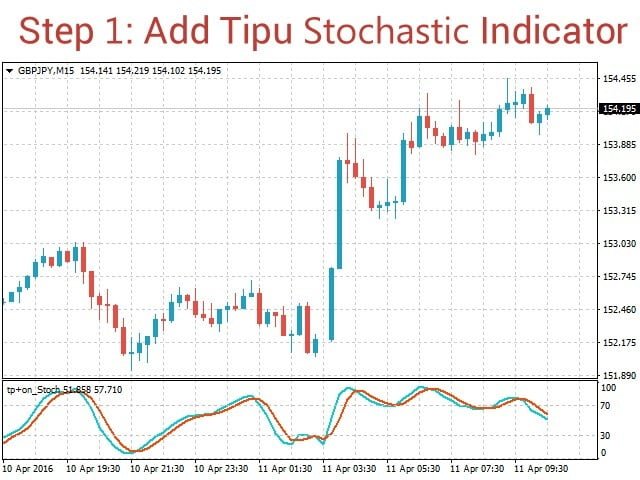Tipu Stochastic is a modified version of the original stochastic oscillator published by MetaQuotes here.
- Three types of sign (turns, the intersection of the main signal, crossing the overbought/oversold).
- Customizable buy/sell alarms, push notifications, email alerts, and a pop-up message onto the display.
- Marks overbought and oversold amounts.
add the Tipu Panel (found here) and unlock additional features:
- An easy-to-use panel which shows the tendency signal of the chosen timeframes.
- displays the stochastic values on the chosen timeframes.
- A custom panel. The panel could be placed anywhere on the graph or dropped to free up space.
The stochastic oscillator was developed by George C. Lane in the 1950s. This is a momentum indicator that compares the closing price of an instrument in relation to its price range (high – low) over a period of time. George Lane argued that the stochastic oscillator does not follow price, volume, or anything like that. It works based on the speed or momentum of the price. As a rule, the momentum changes its direction before the price changes.
[spoiler title=”Read More…”]
The stochastic oscillator goes up when the closing price is in the upper range (that is, the closing price is near the maximum of this period). With a strong trending market, Stochastic can remain in the overbought/oversold area for a long period of time. A trading signal can be formed when the Stochastic crosses overbought/oversold levels. It can also appear when the main line changes its direction and starts moving in the opposite direction. Stochastic can also be used for divergence signals. Divergence occurs when the directional movement of the Stochastic is not confirmed by the price action. For example, a bullish divergence occurs when a lower low is recorded on the EURUSD pair, and the Stochastic forms a higher low. This means that the EURUSD is losing momentum and a bullish correction is possible.
Stochastic crossover can also provide trading signals when used with the fluctuations of the trend line forming candles, levels of support and resistance.
%K = (CLOSE-LOW(%K))/(HIGH(%K)-LOW(%K))*100
%D = SMA(%K, N)
%K = (CLOSE-LOW(%K))/(HIGH(%K)-LOW(%K))*100
%D = SMA(%K, N)
A full description of the stochastic oscillator is available here.
- Show Panel? – display settings, true/false-show / hide the panel (you need to add the Tipu Panel to the chart).
- Short Name for the Panel – short name for the panel title on the Tipu Panel.
- Panel Display – what should be displayed in the Tipu Panel.
- Buy / Sell signal – “B” – buy signal,” S ” – sell signal.
- Stochastic plot-displays the Stochastic value on the chart.
- K Period – Stochastic settings.
- D Period – Stochastic settings.
- Slowing – Stochastic settings.
- Average Method-Stochastic settings.
- Price-Stochastic settings.
- Overbought – Stochastic oscillator settings.
- Oversold – Stochastic oscillator settings.
- Types of signals
- Mark Buy / Sell Signals-visual display of buy/sell signals: arrows, vertical lines, or nothing.
- Arrow offset (pips) – indent of arrows from High (for sell) and Low (for buy) in pips (works only if Mark Buy/Sell Signals = Arrow). Increasing the margin (in pips) moves the arrows further away from the high / low of the candle.
- Buy/Sell Colors – icon colors.
- Reverse-generates a trading signal when the Stochastic changes direction. For example, a buy signal will be generated if the Stochastic was at the bottom of the previous analyzed candle, and it is at the top of the current one.
- Main Signal Cross-generates a trading signal when the main line crosses the signal line.
- OS OB Cross-generates a trading signal when the main line crosses the overbought or oversold level.
- Alert Shift – delay of the candle on the signal, enter 1 to send an alert after passing 1 candle.
- Alert Mobile–true/false, sending push notifications to the mobile device, you must specify the appropriate settings.
- Alert onscreen on change–true/false, the message on the terminal screen is displayed in a separate window.
- Alert email on change–true/false, email alerts, you must specify the appropriate settings.
- Buy / Sell signal – “B” – buy signal,” S ” – sell signal.
- Stochastic plot-displays the Stochastic value on the chart.
- Mark Buy / Sell Signals-visual display of buy/sell signals: arrows, vertical lines, or nothing.
- Arrow offset (pips) – indent of arrows from High (for sell) and Low (for buy) in pips (works only if Mark Buy/Sell Signals = Arrow). Increasing the margin (in pips) moves the arrows further away from the high / low of the candle.
- Buy/Sell Colors – icon colors.
- Reverse-generates a trading signal when the Stochastic changes direction. For example, a buy signal will be generated if the Stochastic was at the bottom of the previous analyzed candle, and it is at the top of the current one.
- Main Signal Cross-generates a trading signal when the main line crosses the signal line.
- OS OB Cross-generates a trading signal when the main line crosses the overbought or oversold level.
1 Lane, G. (1986) Using Stochastic, Cycles, and R.S.I to the Moment of Decision. Watseka, I.L.: Investment Educators.
[/spoiler]





